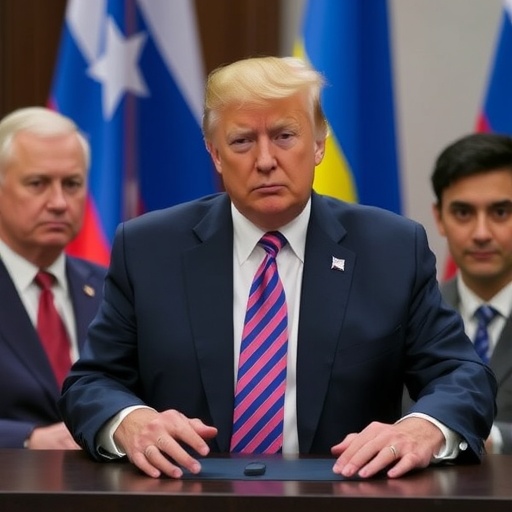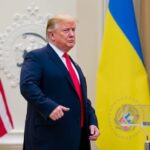Trump Urges Ukraine to Cede Donbas Territory to Russia for Swift Peace as Putin Summit Looms
In a provocative move that has sent shockwaves through international diplomacy, President Donald Trump has publicly suggested that Ukraine relinquish control over much of its Donbas region to Russia as a prerequisite for ending the protracted war. This statement, delivered during a recent interview, underscores a potential pivot in U.S. foreign policy, emphasizing territorial concessions over prolonged military support. As preparations accelerate for a high-stakes Trump-Putin summit in Budapest, the proposal highlights escalating tensions and the fragile path toward peace between Ukraine and Russia.
Trump’s Stark Proposal: Dividing Donbas for War’s End
President Trump, known for his unfiltered approach to global conflicts, laid out his vision for resolving the Ukraine-Russia war with blunt clarity. “The Donbas should be cut up, and most of it left in Russian hands,” Trump stated in an exclusive interview with Fox News, arguing that such a division would bring immediate peace and allow Ukraine to focus on rebuilding. This marks a significant departure from the Biden administration’s staunch opposition to any territorial cessions, which viewed them as rewarding Russian aggression.
The Donbas region, encompassing the Luhansk and Donetsk oblasts in eastern Ukraine, has been a flashpoint since 2014, when pro-Russian separatists, backed by Moscow, seized control amid the Euromaidan Revolution’s aftermath. According to the United Nations, the conflict has claimed over 14,000 lives before the full-scale invasion in 2022, with the region now serving as a symbol of Ukraine’s sovereignty. Trump’s proposal envisions a partition where Russia retains the majority of the territory, potentially including key industrial cities like Donetsk and Luhansk, while Ukraine might negotiate minor border adjustments.
Experts on Ukraine-Russia relations, such as former U.S. Ambassador to Ukraine William Taylor, have criticized the idea as shortsighted. “Ceding Donbas isn’t just about land; it’s about validating Putin’s imperial ambitions,” Taylor remarked in a recent op-ed for The Atlantic. Yet, Trump defenders, including Republican senators like Lindsey Graham, argue that endless aid—totaling over $175 billion from the U.S. since 2022, per the Kiel Institute for the World Economy—has yielded little strategic gain, and a negotiated settlement is overdue.
To illustrate the human cost, consider the stories emerging from Donbas. Families displaced by shelling, now numbering over 4 million internally displaced persons according to UNHCR data, underscore the urgency. Trump’s words have ignited debates on social media, with hashtags like #DonbasDeal trending globally, amplifying calls for peace even as they provoke outrage in Kyiv.
U.S. Policy Shift Signals Pressure on Ukraine’s Zelenskyy
Trump’s comments represent a seismic shift in U.S. stance toward Ukraine, moving from unequivocal support to pragmatic diplomacy that prioritizes de-escalation. During his campaign, Trump repeatedly promised to end the war “in 24 hours,” a pledge now crystallizing into concrete proposals. This evolution is evident in recent White House briefings, where officials have hinted at conditioning future aid packages on Ukraine’s willingness to engage in territorial talks.
Under the previous administration, the U.S. provided Javelin anti-tank missiles, HIMARS rocket systems, and Patriot air defenses, bolstering Ukraine’s defenses against Russian advances in Donbas. However, with U.S. stockpiles strained and domestic fatigue growing—polls from Pew Research show 49% of Americans now favor negotiations over continued funding—Trump’s administration appears poised to leverage its influence more aggressively.
Ukrainian President Volodymyr Zelenskyy, who has positioned himself as a steadfast defender of territorial integrity, faces mounting pressure. In a televised address following Trump’s remarks, Zelenskyy declared, “Ukraine will not trade its land for peace; our sovereignty is non-negotiable.” Yet, behind the scenes, European allies like Germany and France have quietly endorsed dialogue, with Chancellor Olaf Scholz stating at the Munich Security Conference that “realistic compromises” are essential to prevent further bloodshed.
Economically, the stakes are high. Donbas holds 60% of Ukraine’s coal reserves and significant steel production capacity, per World Bank estimates. Losing it could cripple Ukraine’s post-war recovery, projected to cost $486 billion over the next decade. Trump’s push thus intertwines geopolitical strategy with economic realism, challenging Zelenskyy to balance national pride against the war’s toll, which includes over 500,000 casualties on both sides, according to Ukrainian military reports.
Budapest Summit Preparations Heat Up Amid Diplomatic Buzz
As the Trump proposal reverberates, logistical gears are turning for what could be a landmark Trump-Putin summit in Budapest, Hungary. The neutral venue, selected for its historical role in Cold War-era talks, symbolizes a return to direct U.S.-Russia engagement. Sources close to the White House confirm that preliminary agendas include discussions on Ukraine, NATO expansion, and energy sanctions, with Donbas concessions likely topping the list.
Hungarian Prime Minister Viktor Orbán, a vocal critic of EU sanctions on Russia, has offered Budapest’s facilities, including the historic Buda Castle, for the meeting. This choice isn’t coincidental; Orbán’s government has maintained economic ties with Moscow, importing 80% of its gas from Russia despite diversification efforts. Preparations involve secure communications lines and protocol teams from both nations, with U.S. Secretary of State Mike Pompeo—expected to reprise a key role—overseeing logistics.
However, the summit’s viability hinges on mutual goodwill. Trump has praised Putin as a “strong leader” in past interviews, while the Russian president has reciprocated by expressing openness to talks. Satellite imagery from Maxar Technologies shows increased activity at Budapest’s airports, hinting at inbound delegations. For Ukraine, exclusion from initial planning raises alarms; Kyiv insists on inclusion, with Foreign Minister Dmytro Kuleba warning that any deal without Ukrainian input would be “a betrayal of international law.”
The Putin summit preparations also spotlight broader U.S.-Russia dynamics. Since the 2022 invasion, bilateral trade has plummeted 90%, per U.S. Commerce Department figures, but opportunities in arms control and Arctic resources could sweeten the pot. Analysts from the Council on Foreign Relations predict the event could yield a ceasefire framework, potentially freezing frontlines in Donbas and paving the way for monitored withdrawals.
Kremlin’s Cautious Stance on Timeline and Terms
From Moscow’s perspective, Trump’s overtures are welcome but met with measured optimism. Kremlin spokesperson Dmitry Peskov acknowledged the proposal, stating, “We appreciate realistic approaches to the Donbas issue, but no precise timeframe for the summit has been set.” This echoes Russia’s long-standing demands for recognition of its annexations, including the 2014 seizure of Crimea and the 2022 referendums in Donbas, which Ukraine and most Western nations deem illegitimate.
Putin’s inner circle, including Foreign Minister Sergey Lavrov, has outlined conditions: lifting Western sanctions, Ukraine’s neutrality pledge, and demilitarization of Donbas. In a recent interview with RT, Lavrov emphasized, “Peace requires Ukraine to accept the new realities on the ground.” Russian state media has amplified Trump’s words, framing them as validation of Moscow’s narrative that the war stems from NATO encroachment rather than unprovoked aggression.
Yet, internal Russian dynamics complicate matters. With the economy strained by sanctions—GDP contracted 2.1% in 2023, according to IMF data—and military casualties estimated at 300,000 by British intelligence, Putin may see the summit as a chance to claim victory without further losses. Public opinion polls from Levada Center indicate 70% of Russians support negotiations, up from 55% in 2022, reflecting war weariness.
International observers, including UN Secretary-General António Guterres, have urged caution. “Any resolution must respect Ukraine’s sovereignty and the Minsk agreements,” Guterres said, referencing the 2015 accords that aimed to grant Donbas autonomy within Ukraine but faltered amid mutual distrust. The Kremlin’s timeline vagueness could be tactical, buying time for battlefield gains in Donbas, where Russian forces recently captured Avdiivka, a key stronghold.
Global Repercussions and Pathways to Lasting Peace
The ripple effects of Trump’s Donbas proposal extend far beyond Ukraine and Russia, potentially reshaping alliances and security architectures. NATO members, particularly Poland and the Baltics, fear a precedent that emboldens authoritarian regimes. Polish President Andrzej Duda warned in a joint presser with Zelenskyy, “Conceding territory today means inviting aggression tomorrow.” Meanwhile, China, a key Russian ally, has remained neutral but could benefit from stabilized energy markets if peace materializes.
For Ukraine, the human and infrastructural toll is staggering. The World Health Organization reports over 10 million Ukrainians need humanitarian aid, with Donbas bearing the brunt—destroyed hospitals, schools, and factories dot the landscape. Rebuilding would require international pledges, possibly tied to any peace deal, with the EU already committing €50 billion in macro-financial assistance.
Looking ahead, the Trump-Putin summit could catalyze multilateral talks involving the OSCE and EU mediators. Success might involve a UN-monitored referendum in Donbas, though fraught with risks of fraud. Failure, however, risks escalation, with U.S. intelligence warning of Russia’s potential use of tactical nuclear weapons if cornered. As delegations converge on Budapest, the world watches whether Trump’s bold vision translates to diplomacy or division.
In the coming weeks, expect intensified shuttle diplomacy, with envoys from Washington and Moscow testing the waters. Ukraine’s resilience, bolstered by Western arms, remains a wildcard—recent drone strikes on Russian oil refineries demonstrate Kyiv’s capacity to disrupt negotiations. Ultimately, a sustainable peace will demand compromises on all sides, but Trump’s intervention has undeniably accelerated the timeline, forcing leaders to confront the war’s endgame.










